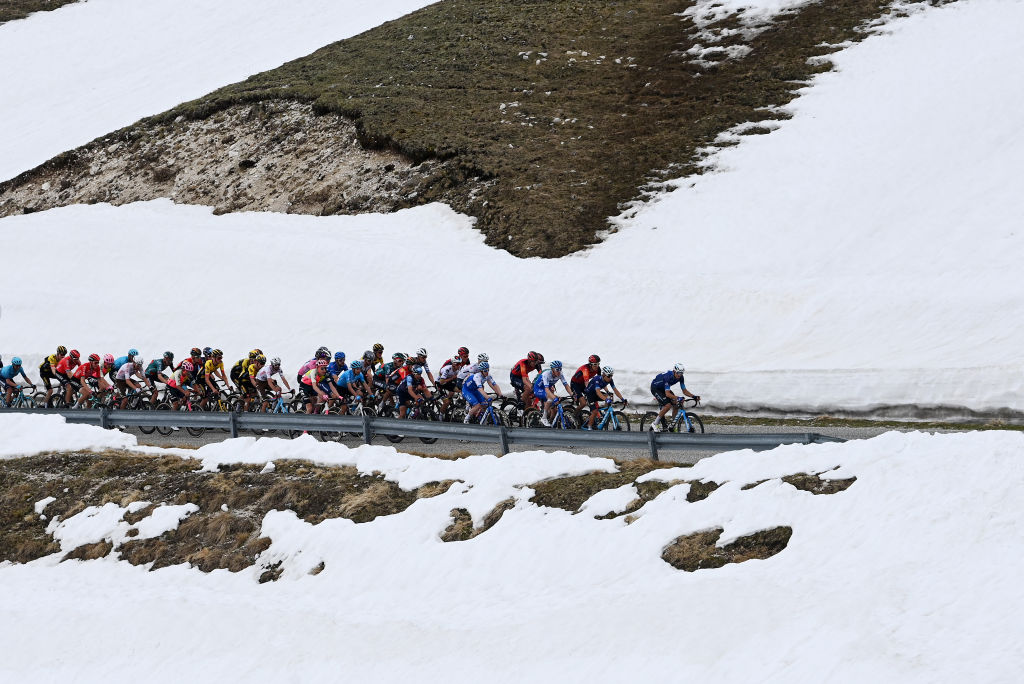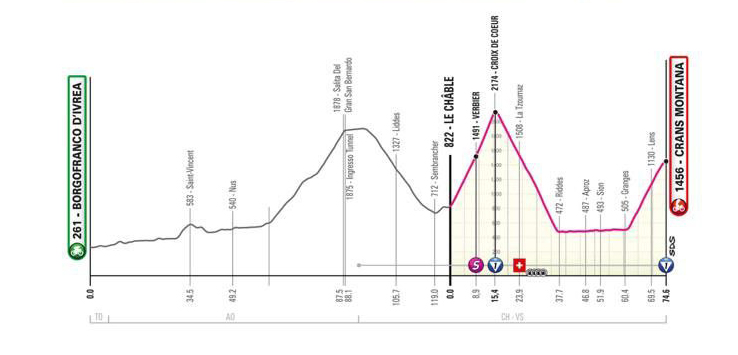Adverse weather forces Giro d'Italia to cut stage 13 to 74.6km
Grand St Bernard Pass cut as race starts at bottom of Croix de Coeur owing to poor conditions out on route

Stage 13 of the Giro d'Italia has been cut to 74.6km in length after the Grand St Bernard Pass was cut from the route altogether due to poor weather conditions on the Giro d'Italia route.
The 135 remaining riders in the race were all present under heavy rain at the start in Borgofranco d'Ivrea but will now take the original neutralised start before re-boarding their team buses and travel to the valley at the base of the day's second climb, the first-category Croix de Coeur.
The decision was taken after a meeting between the teams and race organisers RCS Sport, with 19 of the 22 teams in the race voting to shorten the stage. Riders had proposed to skip the Croix de Coeur due to poor conditions on the descent, but decided to take the option proposed by RCS.
"Given the adverse weather conditions, especially on the Italian side, the Commission decided to meet the athletes' requests by applying the Extreme Weather Protocol," race organisers announced. "Stage 13 will be shortened with the new km 0 being set at Le Chable, at the bottom of the Croix de Couer. The final part of the stage remains unchanged. The race will follow the original timetable."

"It's a big chat last night with the CPA," race leader Geraint Thomas said at the start. "All the teams voted on what they wanted to do. To be honest, I think it's a good decision. I think it's still going to be a super hard stage. It just means we're not in this cold, wet weather for even longer.
"We've seen so many guys going home with sickness, so if we want to get to Rome with at least 50 guys, it's a good decision. It's still going to be hard racing, so I think it's a decent compromise."
As a result, the 199km stage will miss the already altered ascent of the Grand St Bernard Pass entirely, instead taking on the 15km climb past Verbier and follow the original route on to the summit finish at Crans-Montana.
Get The Leadout Newsletter
The latest race content, interviews, features, reviews and expert buying guides, direct to your inbox!
The stage had already been subject to changes, with the road at the top of the Grand St Bernard Pass, previously the Cima Coppi as the highest point of the race, set to be bypassed due to snow at the summit and a risk of avalanches.
The decision to remove the summit road from the race route and instead race through the tunnel lower down the mountain was made earlier this week. However, the mountain – as well as the opening 60km of valley road – has been cut from the route.
Giro d'Italia race director Mauro Vegni explained the decision to bypass the opening 125km of the day's racing.
"There was a request from the riders and to change the route of the stage because of the extreme weather protocol," he said. "We met and we agreed that the important part of the stage would go ahead with the climb and descent of the Croix de Coeur and the climb up to the finish in Crans Montana.
"The riders will go over the San Bernardo by bus and then the new start will be at 14.37 in Sembrancher for a stage of 80km. I have to say it's never easy to find an agreement because everyone has their own interests. My interest is the Giro."
Movistar rider Carlos Verona gave some insight into how the new route had been agreed upon in a meeting ahead of the stage start.
"We voted and 19 of out 22 teams voted to shorten the stage," the Spaniard told Eurosport. "We proposed to skip the second climb, but it looks like now RCS wants us to race from Verbier, which is fine – we want to race to go on, we want to race.
“But we want to try to make it at least possible for us to survive today. Because with too long distance it can be very hard, so we proposed this solution. RCS proposed the other one, so we’re going to take it and see.”
However, not all riders in the peloton were in agreement on the decision to race the Croix de Coeur. Bahrain Victorious co-leader Jack Haig said that riders chasing back on after a furious climb won't have time to put on clothes on what will be a freezing descent.
"I've seen we're starting the last two climbs but to be honest I don't fully agree," he told CyclingPro at the start. "One of the main reasons that we didn't want to do the middle climb was because the road surface on the downhill was potentially dangerous and we wouldn't have time to put clothes on.
"And now we're starting at the bottom of the climb where we're going to race full and get very hot, so not needing many clothes. Then doing the downhill with potentially guys racing to bridge back to the groups they've been dropped from on a downhill that we've discussed is dangerous, so I don’t really understand the compromise, but yeah…"
Dani Ostanek is Senior News Writer at Cyclingnews, having joined in 2017 as a freelance contributor and later being hired full-time. Before joining the team, she had written for numerous major publications in the cycling world, including CyclingWeekly and Rouleur. She writes and edits at Cyclingnews as well as running newsletter, social media, and how to watch campaigns.
Dani has reported from the world's top races, including the Tour de France, Road World Championships, and the spring Classics. She has interviewed many of the sport's biggest stars, including Mathieu van der Poel, Demi Vollering, and Remco Evenepoel, and her favourite races are the Giro d'Italia, Strade Bianche and Paris-Roubaix.
Season highlights from 2024 include reporting from Paris-Roubaix – 'Unless I'm in an ambulance, I'm finishing this race' – Cyrus Monk, the last man home at Paris-Roubaix – and the Tour de France – 'Disbelief', gratitude, and family – Mark Cavendish celebrates a record-breaking Tour de France sprint win.